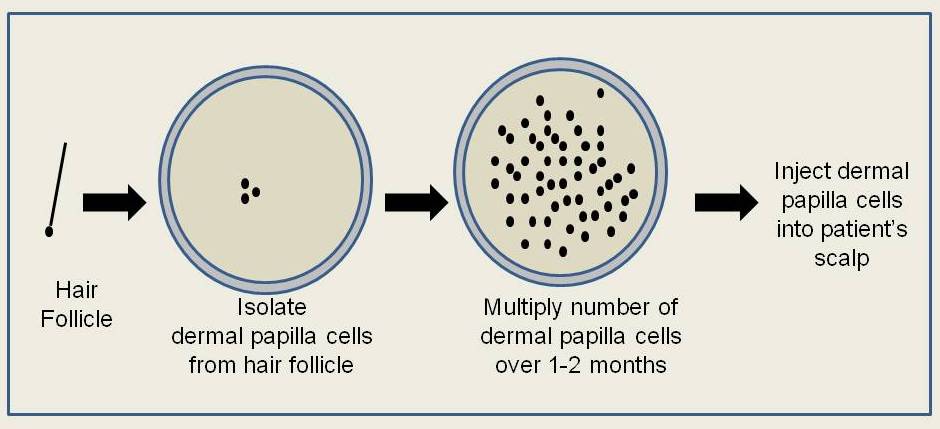Hair Cloning: Does it change the future of hair restoration?
New
innovations in hair restoration are occurring as a result of a new breakthrough in non-invasive procedures to combat hair loss. An international team lead by Dr. Robert Jones are perfecting new innovations that could clone healthy hair follicle cells to produce new hair growth rather than the option of transplants.
Dr. Robert Jones has been recognized worldwide for his techniques in hair transplants. He has been perfecting these types of technology since 2003 and was one of the first doctors to ever successfully perform a large Session FUE transplant. Jones now specialises in hair transplants for beards, eyebrows and more.
Hair cloning procedures with cloning use roughly 50 healthy follicle cells which are extracted in an FUE procedure from healthy portions of a patient’s scalp. These healthy follicles are then preserved and multiplied grown in cultures. The newly produced and cloned cells could then be implanted like a hair transplant but without the need to remove and reposition so many hair follicles.
The current holdup with this procedure is that laws in the United States and Canada directly prevent the use of cloning. Doctors today are working diligently in other parts of the world to perfect this procedure. As 85% of men and 40% of women across North America experience some form of significant hair loss by 50 years old, there is a need to make this form of hair transplant a norm within
the medical world. Being able to maximize hair transplant results with cloned healthy cells can lead to a more natural look in hair transplant as well as thicker hair transplant solutions.

Currently, FUE hair transplants remain the premiere method for hair transplant within North America until this cutting edge surgical option is available. FUE produces
immediate results and with a skilled surgeon, it can create a very natural look with healthy, stimulated growth after the follicles are implanted.
Posted in
Hair Transplant by:
Sang Ale
2018-10-24 | Hairfear
Frequently asked questions about hair transplant procedures
How much does a hair transplant cost?
Hair transplants can vary in price based off of the area in the world that you are interested in getting a hair transplant as well as the size of the area where you may need a hair transplant. Experienced doctors in the United States will often charge some of the highest prices for a hair transplant worldwide and this is why so many travelers make the move to other parts the world like Turkey, India, Thailand, Mexico...etc for their hair transplants.
Will a hair transplant hurt?
Although hair transplants may look like a particularly
unpleasant or painful experience is actually very little discomfort involved
with the surgery itself. Hair transplants are always done under an anesthetic so there's absolutely zero pain during the treatment itself. Many people actually relate the process as being very similar to going to the dentist for filling or root canal. Mild pain can persist over the course of postop treatment but he generally just resumes for a few days.
Who can deliver the best surgery?
It's usually best to consider working with surgeons who have and IAHRS certification or international alliance of hair restoration surgeons recognition. IAHRS can often deliver recommendations for the best surgeons in each particular area.
Is this scarring noticeable?
Any type of hair transplant will require the use of incisions throughout the scalp. There can also sometimes be a small scar from the donor area towards the back of the scalp. Asking to look at photos of the surgeon's previous work will help you to see roughly how bad the scarring could be. In most cases an experienced professional can limit the look of scarring and noticeable marks from the surgery.
How long does it take for the hair to grow?
In most cases hair growth will start within eight months and you can start to see a full effect from the hair transplant after a full year. The initial signs of growth can usually start between 3 to 4 months after the surgery.
Are the results permanent?
The hair follicles that are transplanted are generally the ones which are genetically resistant against the symptoms of baldness. As long as you receive hair loss treatment later in your life after the symptoms of balding have started to subside, you can have a better chance at permanent results.
While everyone know you've had surgery?
If you want to limit the chance that people may find out about your surgery it's important to give at least three weeks of healing as the surgical area will be affected and red just after surgery. After around a month of healing it can look far less noticeable. You could consider wearing a hat while time passes or opting for some extra time off if possible.
How long should I rest after surgery?
It's recommended to rest for at least a few days after surgery so that your body can recover. Trenton to over exert yourself and limit sexual activity, running in the gym for around 10 days after surgery.
Is it possible to lose more hair as a result of surgery?
There is always a chance of shock loss which happens when the hair is weak and miniaturizing after the surgery. As long as the surgeon is choosing the correct hair follicles and performing the surgery well it's possible to minimize the chance of this happening however.
Will I need another hair transplant?
The need for another transplant really depends on the individual. With a solid foundation surgery and working to potentially bolster results with drug therapy, you can improve the stability of the hair that was transplanted as well as prevent further loss. Getting a hair transplant early
on in your 20s or early on in life could lead to needing long-term transplants as hair loss can be progressive.








